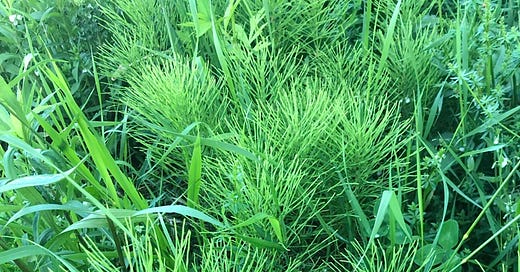Common Horsetail (Equisetum arvense), also called Field Horsetail or Bottlebrush, is a perennial of a very old and prehistoric class of plants that reproduce by spores rather than seeds. Horsetail is a mineralizing nutritive tonic high in silica that grows abundantly in this region. Traditionally harvested in the Spring, it is now at its peak for harvest.
A FEW NOTES ON SAFETY
Common horsetail must be properly prepared in order to reduce intake of an enzyme that can interfere with Vitamin B1 use in the body. Temperatures over 80C (such as in making a tea infusion or decoction) as well as an alcohol level over 30% are both known to denature this enzyme. It is not recommended to consume the plant whole or to consume the remaining plant material after making a tea or tincture. It is traditionally harvested in the Spring as older horsetail is not considered desirable for medicine. I assume this is probably due to concerns over an increase in the level of this enzyme later in the season. Hence we talk about using “Spring Horsetail”.
There are particular concerns about its toxicity to livestock when consumed by horses in large amounts in dry hay. For example, it can have detrimental effects on horses if consumed in large quantities (e.g., 2 kg (4-5 lb) per day for a 454-kg (1,000-lb) horse, for 1-2 weeks).1. Some sources identify a different species as being more problematic in this regard - Equisetum palustre specifically. So make sure you have the correct species when harvesting. There are other species of Equisetum that have concerns regarding possibly higher levels of this enzyme as well.
MEDICINCAL PROPERTIES OF EQUISETUM ARVENSE
Being high in silica, it helps strengthen and beautify the hair, skin and nails. As a musculoskeletal tonic it is said to have a special affinity to rebuilding cartilage. It is known to strengthen connective tissue and joints and has been found helpful in rheumatism and arthritis. It helps address issues of osteoporosis, strengthens the spine and supports the integrity of the intervertebral discs. Its high level of silica contributes to its ability to help clear scar tissue and address slow healing wounds.
This effect of strengthening the connective tissue extends to supporting the lining of the vasculature protecting the arteries and veins. It can help address capillary fragility, lessen bleeding tendencies and help heal tendency to hemorrhoids. This vascular effect extends to the cerebral circulation where it has been used to help heal post stroke. Interestingly it has been found helpful in chronic nosebleeds as well as increased intraocular pressure.
Dr. Dietrich Klinghardt has identified it as being helpful in the elimination of aluminum which may also contribute to some of its cerebrovascular effects.
Horsetail has an affinity to the respiratory system, being used for wet cough with excess mucous, chronic bronchitis and emphysema where it no doubt helps by clearing scar tissue and strengthening cartilage.
Horsetail can be helpful for hayfever and allergic states characterized by red, hot and inflammed mucosa. As we know that allergies are often associated with issues in the gut, it’s not surprising that horsetail has been shown to strengthen and heal the gut mucosa. It also helps heal and tonify the mucosal lining of the bladder, making it helpful for chronic urinary irritation, frequent urination, urinary incontinence and nocturnal enuresis. In these situations it is often used together with other supportive herbs.
Having a diuretic effect it helps the body eliminate excess fluids without creating a significant loss of electrolytes. It has been used in treating kidney stones and gravel, cloudy mucous-filled urine, dribbling urination and prostate issues.
https://www.ontario.ca/page/toxicity-equisetum-horses




